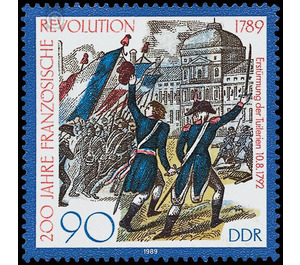200th anniversary of the French Revolution - Germany / German Democratic Republic 1989 - 90 Pfennig
Theme: Architecture
| Country | Germany / German Democratic Republic |
| Issue Date | 1989 |
| Face Value | 90.00 |
| Color | multi-colored |
| Perforation | K 13 |
| Printing Type | Rotogravure 2 |
| Stamp Type | Postage stamp |
| Item Type | Stamp |
| Chronological Issue Number | 3002 |
| Chronological Chapter | GER-DDR |
| SID | 605801 |
| In 11 Wishlists | |
200 years of French Revolution On the occasion of the 200th anniversary of the French Revolution, the Ministry of Posts and Telecommunications of the German Democratic Republic issues three multicolored postage stamps. Special cancellation of 4 July is 3 September 1989 200 years French Revolution On 14 July 1989 marks the 200th anniversary of the day when the masses of Paris stormed the Bastille. This started the Great French Revolution. The anniversary is thought of worldwide. This date also stands in the tradition calendar of the German Democratic Republic for the appreciation of important historical events. The special postage stamp at 90 Pfennig shows how revolutionary Parisian citizens and volunteer soldiers devoted to the Revolution stormed the royal palace, the Tuileries Palace, on 10 August 1792 from all over France. The Swiss Guard and a few hundred armed nobles who ruthlessly opened fire on the invaders could not save the king. The storming of the Tuileries was another great victory of the people over the reaction. The defeat of the Intervention Army in Valmy, the constitution of the National Convention and the proclamation of the Republic in September 1792 were the immediate consequences. A new stage of the revolution began. After these events and the king's execution in January 1793, the war against revolutionary France was fiercely fought. England too now supported the feudal powers of Europe. It feared in bourgeois France the dangerous competitor of its rule on the world market. Enemies of the revolution in the country allied themselves with invasion armies invading from all sides. In this threatening situation, the Jacobins, the most radical faction of the anti-feudal bourgeois opposition, formed an alliance with the masses of the people, with the sans-culottes in the cities and the poor peasants in the countryside. Thus the defense of the revolution was successfully organized.


